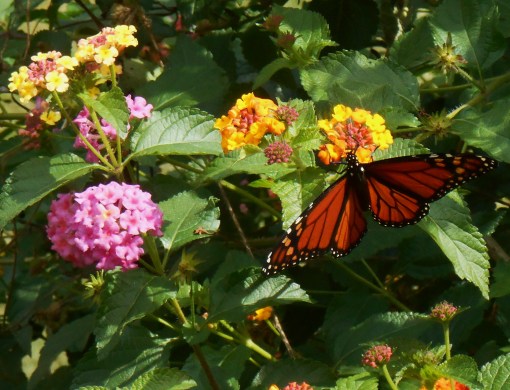Monarchs have returned to our garden. In the past three days I’ve seen Monarch butterflies feeding on several different occasions.
The first time wasn’t in our garden at all. It was Sunday afternoon in far western Chesterfield County.
I was driving out towards Amelia, and made a “U” turn to return to a little roadside nursery. There was a small stand of goldenrod growing in the median, and to our delight, a beautiful Monarch was hovering over the goldenrod. I was thrilled to finally see one again after watching for them all summer.
And then this morning, a Monarch flew past our porch, and lit in the upper branches of our pear tree. We watched it until it took off again. We took it as a very good omen.
Especially since my partner had found, and shared with me, an article about cooperative preservation efforts involving Canada, The United States and Mexico in the current Scientific American magazine yesterday morning.
It is always good when our nations cooperate.
To find a high level of dedication and coordination in an effort to save the Monarch butterfly is astounding.
One idea mentioned in the article, which shows a lot of promise, is to establish corridors of native plants, especially milkweed species, along certain north-south interstate highways.
Monarchs need habitat and food all along the way of their annual migration.
This is such a good idea, it begs the question: Why not establish native plant habitat along ALL of our interstate highways?
I know that many states have planted wildflowers and allowed native plants to grow along their highways. To me, this is not only common sense, but also a beautiful approach to highway maintenance.
It certainly makes a trip more interesting for the traveler to have wide swaths of beautiful flowers and trees to enjoy along the roadside.
It helps travelers get a better “sense of place,” too, to see how native vegetation varies form region to region.
But it also would save each Department of Transportation money that in currently spent mowing the roadsides and medians every few weeks.
Our butterfly and songbird populations both would benefit from corridors of native plants all along our major highways.
I hope that efforts to preserve habitat in Mexico, and efforts to curtail the use of insecticides and herbicides in all three nations prove successful.

This is the patch of roses and Lantana where I found the Monarch this morning. It now reaches well over our heads. The Lantana are several years old, but still die back to the ground each winter. So this is one season’s growth….
Efforts to plant more milkweed should be encouraged and supported by individuals and institutions, in addition to government agencies planting milkweed along the roadsides.
We can all make a small effort towards providing a supportive habitat for wildlife and the specific plants our butterflies need to reproduce.

Many of us plant exotic plants and purely ornamental plants, like these roses, instead of Milkweed and other host plants for butterfly larvae. The dill, fennel and parsley we grew this year, host for swallowtails and other butterflies, weren’t eaten by larvae this season. We have been concerned at how few larvae and butterflies we’ve spotted since spring.
The third Monarch butterfly was feeding on our Lantana when I came out to work in the garden this morning. I was thrilled to find it there, and even happier that it was still blissed out on Lantana nectar when I returned with the camera. It kept peacefully feeding as I joyfully photographed its progress.
When it finally fluttered off, it was to another patch of Lantana a few yards away.
Although Lantana won’t support Monarch larvae, it offers a good food source to fuel the mature Monarchs’ migration this month.
I hope you have recently spotted Monarchs feeding in your community.
October is the time when they gather together for the long trip back to Mexico, where they will spend the winter.
We also hope this winter is gentler to them than last, and that this beautiful species will not only survive, but will respond to our conservation efforts (as many eagles have) and become a common sight in our summer gardens once more.
(All of the links today will take you to interesting and current information on Monarchs and efforts to preserve them.)








Beautiful photos and great thoughts for ways to support wildlife ❤
Thank you, Jane. We still have a Monarch hanging around, and we’re so pleased whenever we spot him. No photos, he was too high today and it was raining, but at least he is still enjoying the Lantana 😉 Looks like a rainy day in the beautiful PNW today. My daughter flew back in to PDX mid-day, and it was snowing on her flight path west. Best wishes, WG
Super post, Elizabeth! I love seeing your visitors – aren’t they so beautiful? They are happily lapping up the Lantana nectar. I will look for that article in SA – thanks for the heads up. I agree with you that leaving the interstate corridors to go wild with mowing annually makes sense in so many ways – a win/win for wildlife and DOT budgets. Imagine driving and seeing miles of wildflowers – pure delight!
Thank you, Eliza. I’m always delighted to find roadways growing in wildflowers, and hope we see more of that with each passing year. Mrs. Johnson initiated the idea decades ago, and it is still a timely one. Painted Ladies were on the Lantana today, and I saw a Monarch only from a distance. So happy they are still here. Best wishes, WG
Lovely pics, WG! 🙂 All quite pretty!